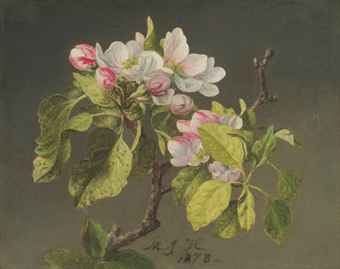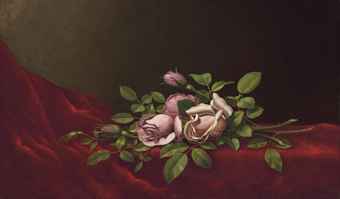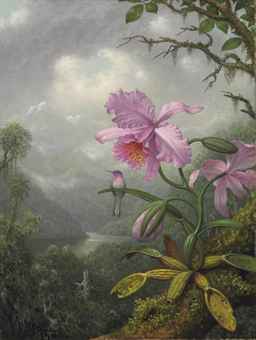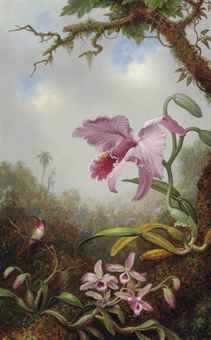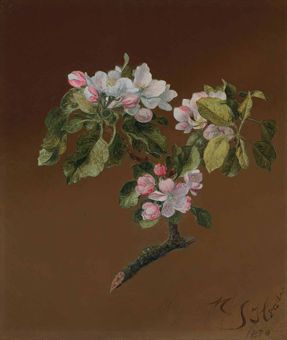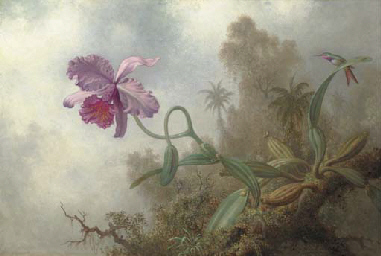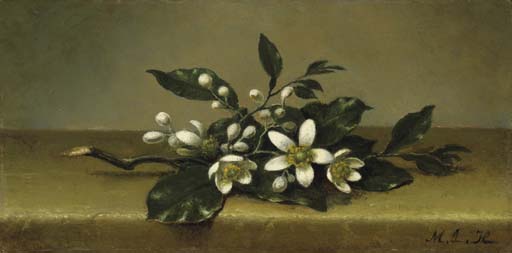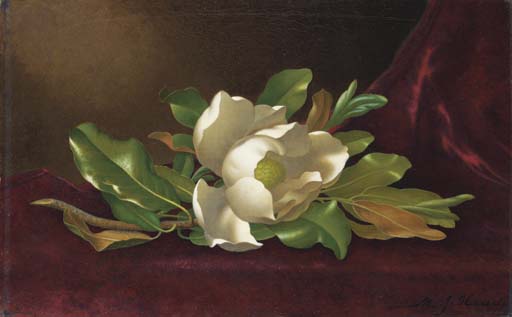Biography
Martin Johnson Heade (originally Heed) was born in Lumberville, in Bucks County, Pennsylvania on August 11, 1819. He received his earliest artistic training from the painter Edward Hicks (1780-1849) and perhaps had additional instruction from Hicks' younger cousin Thomas, a portrait painter. The influence of these two artists is evident in Heade's earliest works, which were most often portraits painted in a rather stiff and unsophisticated manner.Heade traveled abroad around 1838 (the precise date of this first European trip is uncertain), and settled in Rome for two years. He made his professional debut in 1841 when his Portrait of a Little Girl (present location unknown) was accepted for exhibition at the Pennsylvania Academy of the Fine Arts in Philadelphia. In 1843 his Portrait of a Young Lady (present location unknown) was shown at New York's National Academy of Design.
Following a second trip to Europe in 1848 Heade attained a somewhat greater artistic sophistication and began to exhibit more regularly. He moved frequently in the late 1840s and early 1850s, establishing a pattern of itinerancy that would persist throughout his life. Heade gradually concentrated less and less on portrait painting, and by the mid-1850s was starting to experiment with landscape painting.
In 1859 he settled in New York, where he met Frederic Edwin Church, who became one of his few close friends in the American art world. Heade was drawn to coastal areas and began to specialize in seascapes and views of salt marshes; soon he was receiving praise for his ability to capture changing effects of light, atmosphere, and meteorological conditions.
In the late 1850s and early 1860s he began to experiment with still-life painting, an interest he would maintain for the rest of his career. He continued to travel in the eastern United States and then, in 1863, made the first of three trips to South America. Church had already been to the tropics twice, and his large-scale paintings of dramatic South American scenes had won him widespread fame and critical approval. Although Church encouraged his friend to seek out equally spectacular scenery for his own paintings, Heade was generally interested in more intimate and less dramatic views.
While in Brazil in 1863 he undertook a series of small pictures called The Gems of Brazil (c. 1863-1864, Manoogian collection), showing brightly colored hummingbirds in landscape settings. He hoped to use these images in an elaborate illustrated book he planned to write about the tiny birds, but the project was never completed. Nevertheless, he maintained his interest in the subject and in the 1870s began to paint pictures combining hummingbirds with orchids and other flowers in natural settings. During these years he continued to paint marsh scenes, seascapes, still lifes, and the occasional tropical landscape.
In later life Heade's wanderings took him to various spots, including British Columbia and California. Never fully accepted by the New York art establishment--he was, for instance, denied membership in the Century Association and was never elected an associate of the National Academy of Design--Heade eventually settled in Saint Augustine, Florida, in 1883. He was married that same year and at last enjoyed a reasonably stable domestic and professional existence. He also formed the first productive relationship of his career with a patron, the wealthy oil and railroad magnate Henry Morrison Flagler, who would commission and purchase several dozen pictures over the next decade.
Heade continued to paint subjects that he had previously specialized in,
such as orchids and hummingbirds, but he now also turned his attention
to Florida marsh and swamp scenes and still lifes of cut magnolia leaves
and flowers. Heade and his work were largely forgotten by the time of
his death on in St. Augustine on September 4, 1904, and it was only with
the general revival of interest in American art in the 1940s that
attention was once again turned to him and his reputation restored.
Christie’s 2004
Christie's 1999
Christie's 1998
STILL LIFE WITH RED AND PINK ROSES
PR.$74,000
Sotheby's 2012
LOT SOLD. 1,022,500 USD
Sotheby's 2011
LOT SOLD. 1,986,500 USD
National Gallery Of Art
PR.$74,000
Sotheby's 2012
LOT SOLD. 1,022,500 USD
Sotheby's 2011
LOT SOLD. 1,986,500 USD
National Gallery Of Art
-
- Heade, Martin Johnson
- , American, 1819 - 1904
- 1864
- oil on canvas
- overall: 45.5 x 91.1 cm (17 15/16 x 35 7/8 in.)
- framed: 70.2 x 115.9 x 12.1 cm (27 5/8 x 45 5/8 x 4 3/4 in.)
- Gift of the Avalon Foundation
- 1965.2.1
-
- Heade, Martin Johnson
- , American, 1819 - 1904
- Cattleya Orchid and Three Hummingbirds
- 1871
- oil on wood
- overall: 34.8 x 45.6 cm (13 11/16 x 17 15/16 in.)
- framed: 63.8 x 74.6 x 8.9 cm (25 1/8 x 29 3/8 x 3 1/2 in.)
- Gift of The Morris and Gwendolyn Cafritz Foundation
- 1982.73.1
-
- Heade, Martin Johnson (painter)
- , American, 1819 - 1904
- Sunlight and Shadow: The Newbury Marshes
- c. 1871/1875
- oil on canvas
- overall: 30.5 x 67.3 cm (12 x 26 1/2 in.)
- framed: 54.29 × 90.49 × 7.94 cm (21 3/8 × 35 5/8 × 3 1/8 in.)
- John Wilmerding Collection
- 2010.74.1
- On View
-
- Heade, Martin Johnson (painter)
- , American, 1819 - 1904
- Giant Magnolias on a Blue Velvet Cloth
- c. 1890
- oil on canvas
- overall: 38.4 x 61.5 cm (15 1/8 x 24 3/16 in.)
- framed: 65.4 x 87.6 x 7.9 cm (25 3/4 x 34 1/2 x 3 1/8 in.)
- Gift of The Circle of the National Gallery of Art in Commemoration of its 10th Anniversary
- 1996.14.1
